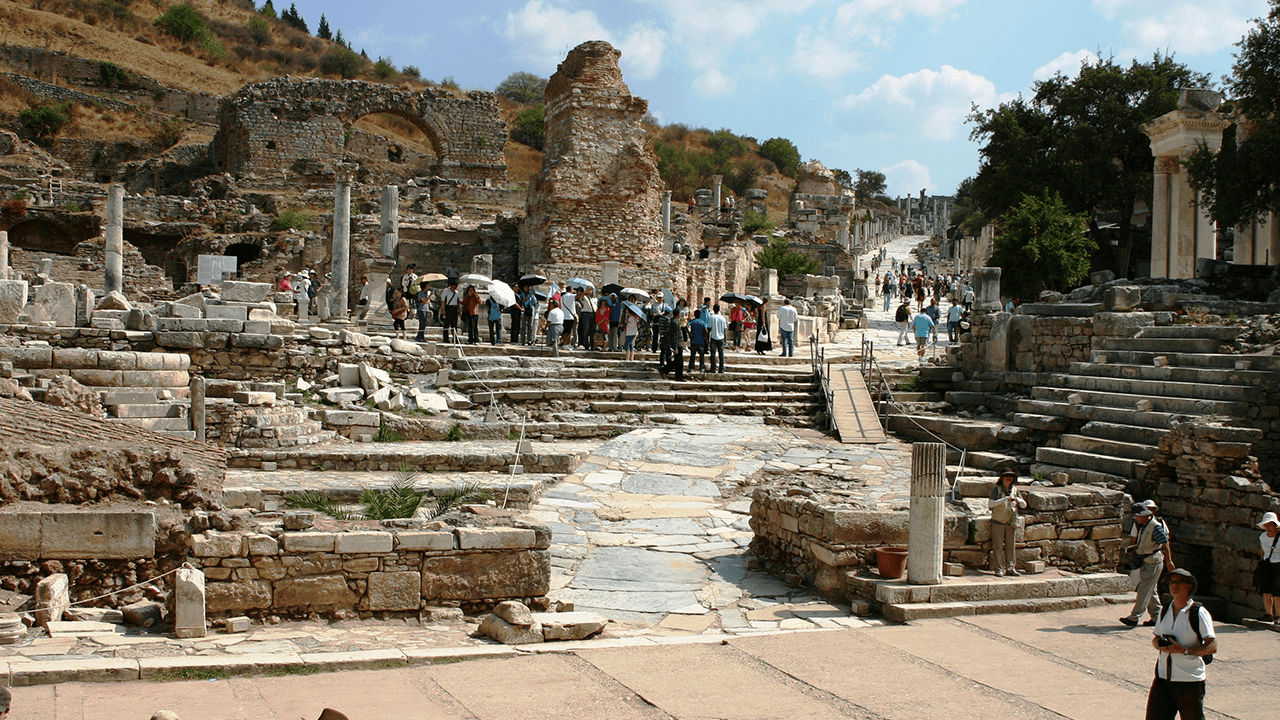The Brothel of Ephesus: A Place of History and Curiosities
Located at the corner of Curetes Street and Marble Road, the brothel of Ephesus is one of the most intriguing buildings discovered in this ancient city. Built during the Trajanic period (98-117 AD), this site not only reveals aspects of daily life in Ephesus but also serves as a fascinating example of the architecture and art of the era.
Identification of the Brothel
The identification of this peristyle house as a brothel is attributed to the discovery of a statue of Priapus, a deity associated with fertility, depicted with a large phallus. This statue, now displayed at the Ephesus Museum, is one of the most emblematic elements of the site.
A Strategic Location
The building features two main entrances: one connecting to Curetes Street and the other to Marble Road. This strategic location made it easily accessible for residents and visitors of Ephesus, emphasizing its role as an integral part of the city’s urban life.
Structure and Design of the Building
The brothel has a complex structure reflecting its multifunctional use. On the ground floor, there is a spacious reception hall adorned with mosaics representing the four seasons. This space was likely used to welcome visitors and clients. The upper floor housed a series of small rooms believed to have been used for private encounters.
Reception Area and Decorations
On the western side of the building, the reception area is decorated with colorful floor mosaics. These mosaics not only enhanced the space aesthetically but also symbolized the cycle of life through representations of the four seasons.
The Bath and Pool
The brothel included a private bath, featuring an elliptical pool decorated with a mosaic on the floor. This mosaic is a work of art in itself, depicting three women enjoying food and drink, a standing waitress serving them, and a curious scene of a mouse and a cat devouring crumbs.
A Space for Relaxation and Luxury
The bath and pool reflect the luxury and attention to detail characteristic of life in Ephesus. These facilities provided visitors with a place to relax and enjoy themselves in a comfortable and artistically decorated environment.
The Footprint Engraved in Marble
At one of the building’s entrances, there is a famous footprint engraved in marble. It is believed that this mark indicated the way for visitors, acting as a kind of sign or advertisement. This detail highlights the ingenuity of the ancient Ephesians in attracting customers and guiding visitors to the brothel.
An Ancient Form of Advertising
The footprint is considered one of the earliest examples of commercial signage, adding a fascinating element to the study of this building. It reflects how advertising was already a part of daily life in the ancient world.
Cultural and Historical Significance
The brothel of Ephesus is not only a site of architectural interest but also a reflection of the customs and social life of the era. Its design, location, and decorative elements offer a unique insight into how various aspects of urban life were integrated into a vibrant city like Ephesus.
A Testimony to Life in Ephesus
This building is a tangible proof of human interactions, artistic expressions, and social practices in ancient Ephesus, providing visitors with a direct connection to the past.
Tips for Visiting the Brothel of Ephesus
- Location: The brothel is located at the corner of Curetes Street and Marble Road, at the heart of the Ephesus archaeological complex.
- Recommended Visiting Time: Visiting early in the morning or at sunset allows for better appreciation of the mosaic details and architecture.
- Respect the Site: As an archaeological site, it is recommended not to touch the mosaics or structures to ensure their preservation.
Conclusion
The brothel of Ephesus is a place that combines history, art, and curiosities of daily life in the ancient world. From the statue of Priapus to the mosaics and the marble footprint, this building offers a fascinating glimpse into Ephesian society. Visiting this site is an opportunity to explore the details of urban life in Ephesus and discover how ancient practices and customs have left their mark on history.


3 thoughts on “The Brothel”
★★★★★
Learning about and visiting ‘The Brothel’ was both fun and educational. Everyone should experience this!
★★★★★
My journey to ‘The Brothel’ was nothing short of amazing. A must-see for anyone exploring the area!
★★★★★
Exploring ‘The Brothel’ exceeded all my expectations. A perfect combination of culture, beauty, and knowledge.